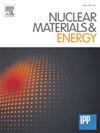机器学习辅助光学发射光谱测定级联电弧等离子体中的电子密度和电子温度
IF 2.7
2区 物理与天体物理
Q1 NUCLEAR SCIENCE & TECHNOLOGY
引用次数: 0
摘要
高密度级联电弧等离子体在线性等离子体器件(lpd)中得到了广泛的应用,其中激光汤姆逊散射(LTS)和发射光谱(OES)是两种常用的诊断基本参数电子密度(ne)和电子温度(Te)的方法。然而,复杂的LTS设置缺乏空间灵活性,而简单的OES精度有限。为了解决这个问题,本研究开发了一个基于网格搜索优化的支持向量机(SVM)的机器学习模型。该模型结合了LTS的高精度和OES的空间灵活性,预测了DUT-PSI级联弧等离子体中的ne和Te。该模型利用四对“双峰”谱线,绕过了等离子体发射光谱的复杂校准。结果表明,当将排放工况作为输入(Case 1)时,模型的R2值为ne约为0.97,Te约为0.92。当排除放电条件并仅使用线强度比(LIRs)作为输入(案例2)时,ne和Te的R2值分别保持在约0.90和0.80。另一个指标,均方根误差(RMSE),遵循与R2相似的趋势。这些发现表明,在这两种情况下,预测的ne和Te与LTS测量结果高度一致。同时,灵敏度分析表明,该模型的预测精度对两种情况下选择的特定谱线组合具有鲁棒性。因此,通过整合LTS和OES的优势,该模型具有无需校准等离子体光谱和灵活的谱线选择的特点,可以全面诊断级联弧等离子体,并显示出在其他类似lpd中的应用潜力。本文章由计算机程序翻译,如有差异,请以英文原文为准。
Machine learning assisted optical emission spectroscopy to determine electron density and electron temperature in a cascaded arc plasma
High-density cascaded arc plasma has been widely applied in linear plasma devices (LPDs), in which the laser Thomson scattering (LTS) and optical emission spectroscopy (OES) are two popular diagnostic methods for the fundamental parameters, electron density (ne) and electron temperature (Te). However, the complicated LTS setup lacks spatial flexibility, while the accuracy of simple OES is limited. To address this, this study develops a machine learning model based on Support Vector Machine (SVM) with a grid search optimization. This model combines the high accuracy of LTS with the spatial flexibility of OES to predict ne and Te in cascaded arc plasma in DUT-PSI. The model utilizes four pairs of “double-peak” spectral lines, bypassing the complicated calibration for plasma emission spectrum. The results show that when discharged conditions are included as input (Case 1), the model achieves R2 values around 0.97 for ne and about 0.92 for Te. When excluding discharge conditions and using only line intensity ratios (LIRs) as input (Case 2), the R2 values for ne and Te remain approximately 0.90 and 0.80, respectively. The other index, root mean square error (RMSE), follows a similar tendency to R2. These findings demonstrate that the predicted ne and Te in both cases are highly consistent with LTS measurements. Meanwhile, sensitivity analysis reveals that the model’s prediction accuracy is robust to the specific combination of spectral lines selected in both cases. Thus, by integrating the strengths of LTS and OES, this model features calibration-free for plasma spectroscopy and flexible spectral line selection, enabling comprehensive diagnosis of cascaded arc plasma and showing potential for application in other similar LPDs.
求助全文
通过发布文献求助,成功后即可免费获取论文全文。
去求助
来源期刊

Nuclear Materials and Energy
Materials Science-Materials Science (miscellaneous)
CiteScore
3.70
自引率
15.40%
发文量
175
审稿时长
20 weeks
期刊介绍:
The open-access journal Nuclear Materials and Energy is devoted to the growing field of research for material application in the production of nuclear energy. Nuclear Materials and Energy publishes original research articles of up to 6 pages in length.
 求助内容:
求助内容: 应助结果提醒方式:
应助结果提醒方式:


